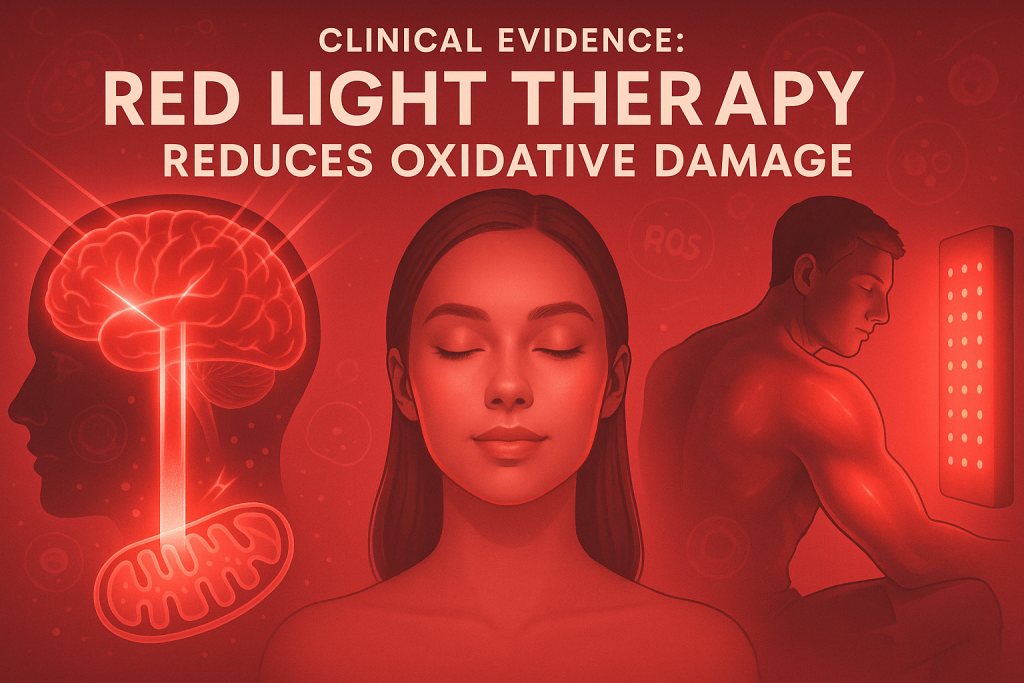Red Light Therapy and Oxidative Stress: Protecting Your Cells from Damage
Oxidative stress is a foundational cause of chronic disease, premature aging, and cellular dysfunction. It arises when there’s an imbalance between harmful reactive oxygen species (ROS) and the body’s antioxidant defense system. While many lifestyle factors—like pollution, smoking, and poor diet—can fuel oxidative stress, red light therapy (RLT) offers a non-invasive, scientifically-backed solution to help mitigate the damage.
In this article, we will examine the connection between Red Light Therapy and Oxidative Stress.
Understanding Red Light Therapy and Oxidative Stress can be crucial for improving overall health.
In this guide, we dive deep into the science of oxidative stress and explore how red and near-infrared light therapy can protect your cells, optimize your antioxidant systems, and restore redox balance.
Key Takeaways: Red Light Therapy and Oxidative Stress
- Red Light Therapy Restores Redox Balance: It helps balance reactive oxygen species (ROS) and antioxidants, preventing cellular damage and slowing aging.
- Boosts Natural Antioxidant Defenses: RLT activates the Nrf2 pathway, increasing the production of glutathione, catalase, and superoxide dismutase (SOD).
- Enhances Mitochondrial Function: By stimulating cytochrome c oxidase, RLT improves ATP production and oxygen efficiency, fueling cellular repair.
- Reduces Inflammation and Oxidative Load: It lowers chronic inflammation markers like TNF-α and IL-6, helping with conditions like fatigue, diabetes, and neurodegeneration.
- Safe, Non-Invasive Cellular Protection: RLT is a drug-free, non-invasive method to protect cells from oxidative stress—ideal for skin health, brain function, and metabolic wellness.
What Is Oxidative Stress and Why It Matters
Oxidative stress occurs when there’s an excess of free radicals—unstable oxygen-containing molecules—in the body that overwhelm the natural antioxidant defense system. This imbalance leads to cellular damage, DNA mutations, and even apoptosis (programmed cell death).
The Balance Between Free Radicals and Antioxidants
- Free radicals: Highly reactive molecules that steal electrons from healthy cells. Common types include superoxide, hydroxyl radicals, and hydrogen peroxide.
- Antioxidants: Molecules like glutathione, catalase, and superoxide dismutase (SOD) that neutralize free radicals and prevent cell damage.
When oxidative stress is left unchecked, it contributes to:
- Accelerated skin aging (wrinkles, collagen degradation)
- Chronic inflammation
- Neurodegenerative diseases (Alzheimer’s, Parkinson’s)
- Metabolic disorders (diabetes, obesity)
- Cardiovascular damage
What Causes Oxidative Stress?
Oxidative stress results from an imbalance between the production of reactive oxygen species (ROS) and the body’s ability to neutralize them with antioxidants. This imbalance can be triggered by both internal and external factors, which either increase ROS production or impair the antioxidant defense system.
Internal Factors:
One of the primary internal contributors to oxidative stress is mitochondrial dysfunction. Since mitochondria are the main producers of cellular energy (ATP) and also the largest endogenous source of ROS, any disruption in their function can lead to excessive free radical generation.
Additionally, an overactive immune response—particularly during infections or chronic immune stimulation can lead to an “oxidative burst,” a rapid release of ROS designed to kill pathogens but which can also damage healthy tissues if uncontrolled.
Another major internal driver is chronic inflammation, which sustains high levels of oxidative molecules that degrade tissues over time.
External Factors:
Several environmental and lifestyle-related exposures also significantly contribute to oxidative stress.
Air pollution, industrial chemicals, and toxic emissions introduce harmful compounds that increase oxidative burden.
Smoking, including second-hand exposure, floods the body with thousands of oxidants. Likewise, ultraviolet (UV) radiation from excessive sun exposure damages skin cells by triggering ROS formation.
Dietary habits also play a major role high intake of processed foods, refined sugars, alcohol, and trans fats accelerates oxidative load. In addition, exposure to pesticides, heavy metals, and environmental toxins compromises detox pathways and weakens antioxidant defenses. Even certain medications, like chemotherapy drugs, can induce oxidative stress as a side effect.
Collectively, these internal and external factors overwhelm the body’s antioxidant systems, tipping the redox balance and leading to widespread oxidative damage at the cellular and tissue level.
How Red Light Therapy Works at the Cellular Level
Red light therapy, or photobiomodulation, uses specific light wavelengths (630–670 nm red light and 810–850 nm near-infrared) to interact with mitochondrial enzymes and modulate cellular processes.
Key Mechanisms:
- Cytochrome c oxidase activation: Enhances electron transport in the mitochondria.
- Nitric oxide displacement: NO can inhibit mitochondrial function; red light releases this inhibition.
- ATP production boost: More cellular energy supports repair and antioxidant activity.
By improving mitochondrial efficiency, RLT helps cells respond better to stress and repair oxidative damage faster.
Red Light and ROS Modulation
Contrary to common belief, red light doesn’t simply “eliminate” ROS. Instead, it fine-tunes ROS levels.
Hormetic Response:
- RLT induces a transient increase in ROS, which acts as a signal for the body to upregulate its natural defenses.
- This short-term oxidative burst activates antioxidant enzymes and leads to improved long-term resilience.
Long-Term Modulation:
- Reduced chronic ROS leakage from dysfunctional mitochondria
- Better oxygen utilization and less oxidative load
This balance between initial stress and enhanced defense is known as hormesis—a beneficial adaptation to low-level stress.
Activating Antioxidant Pathways with Red Light
Red light therapy has been shown to trigger cellular pathways that activate the body’s own antioxidant systems.
Key Pathways:
- Nrf2 Pathway Activation: Red light stimulates Nrf2 (Nuclear factor erythroid 2–related factor 2), a master regulator of antioxidant gene expression.
- Glutathione Production: The body’s most powerful antioxidant, responsible for detoxification and redox regulation.
- Upregulation of Catalase and SOD: These enzymes break down hydrogen peroxide and superoxide radicals.
As a result, RLT strengthens the internal antioxidant network and prepares the body to neutralize oxidative threats more effectively.
Clinical Evidence: Red Light Therapy Reduces Oxidative Damage

Numerous studies have demonstrated the effectiveness of red light therapy in reducing markers of oxidative stress in both animal and human models.
Brain & Nervous System:
- Neurodegenerative diseases: RLT reduces oxidative stress and restores mitochondrial function in brain tissue, particularly in Alzheimer’s and Parkinson’s models.
- Stroke recovery: Enhanced mitochondrial respiration and reduced ROS in hypoxic brain tissue.
Skin and Aging:
- Anti-aging effects: Red light promotes collagen synthesis and reduces wrinkle depth via oxidative stress reduction for more visit Skin Rejuvenation & Anti-Aging
- Wound healing: Speeds up skin repair by enhancing ATP and minimizing ROS overload.
Muscle and Recovery:
- Athletic recovery: RLT before or after workouts reduces oxidative muscle damage, accelerates repair, and improves performance.
Metabolic and Systemic Benefits:
- Diabetes: Reduces oxidative markers and improves insulin sensitivity.
- Chronic fatigue: Enhances mitochondrial health and reduces fatigue-inducing ROS.
Summary Table: Red Light vs Oxidative Stress
| Mechanism | Molecule / Pathway | Outcome |
| ROS Modulation | Cytochrome c Oxidase | Balanced redox state |
| Antioxidant Activation | Nrf2, Glutathione, SOD, Catalase | Stronger cellular defense |
| Oxygen Efficiency | NO Dissociation | Enhanced mitochondrial respiration |
| Inflammation Control | TNF-α, IL-6 (downregulation) | Reduced chronic inflammation |
| Hormetic Adaptation | ROS Burst | Long-term resilience and healing |
FAQs About Red Light Therapy and Oxidative Stress
Can red light therapy help with oxidative stress?
Yes. RLT helps balance ROS levels and enhances your body’s internal antioxidant systems.
How often should I use red light therapy for oxidative stress?
For general wellness: 3–5 times per week. For clinical conditions: consult a medical practitioner.
Does red light increase free radicals?
Initially yes, but in a controlled, beneficial way. This mild oxidative burst stimulates your antioxidant defense.
Is near-infrared light better than red light for oxidative damage?
Near-infrared penetrates deeper, so it’s more suitable for internal organs or brain tissue. Red light is ideal for skin and superficial tissues.
Can red light therapy replace antioxidants in my diet?
No. RLT complements antioxidant intake by improving your body’s own defense systems. A nutrient-rich diet is still essential.
Conclusion
Oxidative stress is a silent contributor to aging, inflammation, and chronic disease. While lifestyle factors play a major role, red light therapy provides a non-invasive, science-backed tool to restore redox balance and protect your cells from damage.
Through mitochondrial support, antioxidant activation, and ROS modulation, RLT offers a unique method to enhance your health at the cellular level. Whether you’re an athlete, biohacker, or dealing with chronic conditions, integrating red light therapy into your wellness routine can empower your body’s ability to heal and thrive.
Resources:
- Effect of red light and near infrared laser on the generation of reactive oxygen species in primary dermal fibroblasts (2018): PMC Article
- Effect of red light and near infrared laser on the generation of reactive oxygen species in primary dermal fibroblasts (2018): ScienceDirect Abstract
- Mechanisms and applications of the anti-inflammatory effects of photobiomodulation (2017): PMC Article
- Red light-emitting diode irradiation regulates oxidative stress and inflammation through SPHK1/NF-κB activation in human keratinocytes: ScienceDirect Manuscript
- Method for the assessment of effects of a range of wavelengths and intensities of red/near-infrared light therapy on oxidative stress in vitro (2015): PubMed Article
- Comparative assessment of phototherapy protocols for reduction of oxidative stress in partially transected spinal cord slices undergoing secondary degeneration (2016): Curtin University Repository
- Method for the assessment of effects of a range of wavelengths and intensities of red/near-infrared light therapy on oxidative stress in vitro (2015): Curtin University Repository








2 Comments